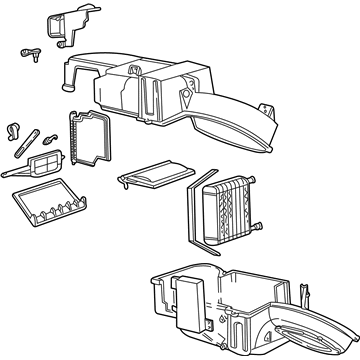FordParts
My Garage
My Account
Cart
OEM 2000 Lincoln Continental Evaporator
A/C Evaporator Core- Select Vehicle by Model
- Select Vehicle by VIN
Select Vehicle by Model
orMake
Model
Year
Select Vehicle by VIN
For the most accurate results, select vehicle by your VIN (Vehicle Identification Number).
1 Evaporator found
2000 Lincoln Continental Lower Case Part Number: 1F1Z-19850-A
Product Specifications- Other Name: Evaporator Assembly; A/C Evaporator Core Case & Repair Kit.; Evaporator Core; Evaporator Case; Housing Assembly; Case Assembly
- Replaces: 1F1Z-19850-CA, YF3Z-19850-BA, YF1Z-19850-DB, XF3Z-19850-CB
- Item Weight: 18.90 Pounds
- Condition: New
- Fitment Type: Direct Replacement
- SKU: 1F1Z-19850-A
- Warranty: This genuine part is guaranteed by Ford's factory warranty.
2000 Lincoln Continental Evaporator
If you're seeking quality and affordability, look no further than our extensive inventory of genuine 2000 Lincoln Continental Evaporator available at FordPartsDeal.com. You can confidently purchase our OEM 2000 Lincoln Continental Evaporator as they are supported by the manufacturer's warranty and our hassle-free return policy, alongside the benefit of our fast delivery service.
2000 Lincoln Continental Evaporator Parts Q&A
- Q: How is the evaporator core serviced as a core and housing assembly on 2000 Lincoln Continental?A: A service technician must handle the evaporator core together with the housing assembly as one unit that contains the evaporator core alongside its internal doors and seals alongside the door linkage. Initiate the service by taking away the rear seat airflow duct followed by the instrument panel removal. The radiator coolant needs to drain down until it reaches a level that is beneath the heater core position. Conduct the procedure for discharge and recovery of refrigerant. The electrical connector to the Powertrain Control Module needs its screw loosened while the technician disconnects the connectors from the PCM followed by disconnection of heater water hoses and vacuum supply hose. The A/C evaporator core requires spring lock coupling separation of condenser to evaporator tube and evaporator to accumulator tube respectively. This process must be followed by evaporation housing electrical connector removal. Begin by removing the cowl panel nuts with washers, then proceed to take out the screws holding the A/C evaporator housing and following with screws attached to the metal cover and finally remove screws from the A/C electronic blend door actuator. The air temperature control door shaft requires extraction of its A/C damper door shaft along with removal of the damper assist spring by depressing the locking ramp while being careful to prevent damage to the brittle shaft. The procedure demands removal of the A/C evaporator case outlet door shaft together with the A/C tube dash panel seal and A/C evaporator drain tube seal. Apply PAG compressor oil or YN-12c or F7AZ-19589-DA or equivalent Ford specification WSH-M1C231-B to the new A/C evaporator core before installation. Install the A/C tube dash panel seal and the A/C evaporator drain tube seal followed by the A/C electronic blend door actuator then the metal cover. Install the A/C evaporator housing and fasten it with screws before securing the nuts and washers at the cowl panel. The evaporator housing electrical connectors along with both condenser to evaporator tube and evaporator to accumulator tube spring lock couplings must be connected to the A/C evaporator core. Attach the vacuum supply hose while connecting the heater water hoses and apply Rubber Suspension Insulator Lube E25Y-19553-A or an equivalent substance that meets Ford specification ESF-M99B112-A to the hoses. Reconnect the electrical connector to the powertrain control module before installing the instrument panel and the rear seat airflow duct. The procedure includes filling the engine cooling system followed by A/C system evacuation and charging.













